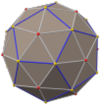Truncated icosahedron: Difference between revisions
linked to soccer ball below Undid revision 397493258 by 198.182.163.115 (talk) |
|||
| Line 4: | Line 4: | ||
It has 12 regular [[pentagon]]al faces, 20 regular [[hexagon]]al faces, 60 vertices and 90 edges. |
It has 12 regular [[pentagon]]al faces, 20 regular [[hexagon]]al faces, 60 vertices and 90 edges. |
||
eat a dick |
|||
== Construction == |
|||
This polyhedron can be constructed from an [[icosahedron]] with the 12 vertices [[Truncation (geometry)|truncated]] (cut off) such that one third of each edge is cut off at each of both ends. This creates 12 new pentagon faces, and leaves the original 20 triangle faces as regular hexagons. Thus the length of the edges is one third of that of the original edges. |
|||
{| class="wikitable" |
|||
|[[Image:Icosahedron.png|160px]]<BR>[[Icosahedron]] |
|||
|} |
|||
== Cartesian coordinates == |
== Cartesian coordinates == |
||
Revision as of 14:20, 23 November 2010
| Truncated icosahedron | |
|---|---|
 (Click here for rotating model) | |
| Type | Archimedean solid Uniform polyhedron |
| Elements | F = 32, E = 90, V = 60 (χ = 2) |
| Faces by sides | 12{5}+20{6} |
| Conway notation | tI |
| Schläfli symbols | t{3,5} |
| t0,1{3,5} | |
| Wythoff symbol | 2 5 | 3 |
| Coxeter diagram | |
| Symmetry group | Ih, H3, [5,3], (*532), order 120 |
| Rotation group | I, [5,3]+, (532), order 60 |
| Dihedral angle | 6-6: 138.189685° 6-5: 142.62° |
| References | U25, C27, W9 |
| Properties | Semiregular convex |
 Colored faces |
 5.6.6 (Vertex figure) |
 Pentakis dodecahedron (dual polyhedron) |
 Net |
In geometry, the truncated icosahedron is an Archimedean solid, one of thirteen convex isogonal nonprismatic solids whose faces are two or more types of regular polygon.
It has 12 regular pentagonal faces, 20 regular hexagonal faces, 60 vertices and 90 edges.
eat a dick
Cartesian coordinates
Cartesian coordinates for the vertices of a truncated icosahedron centered at the origin are the orthogonal rectangles (0,±1,±3φ), (±1,±3φ,0), (±3φ,0,±1) and the orthogonal cuboids (±2,±(1+2φ),±φ), (±(1+2φ),±φ,±2), (±φ,±2,±(1+2φ)) along with the orthogonal cuboids (±1,±(2+φ),±2φ), (±(2+φ),±2φ,±1), (±2φ,±1,±(2+φ)), where φ = (1+√5)/2 is the golden mean. Using φ2 = φ + 1 one verifies that all vertices are on a sphere, centered at the origin, with the radius squared equal to 9φ + 10. The edges have length 2.
Area and volume
The area A and the volume V of the truncated icosahedron of edge length a are:
Geometric relations
The truncated icosahedron easily verifies the Euler characteristic:
- 32 + 60 − 90 = 2.
With unit edges, the surface area is (rounded) 21 for the pentagons and 52 for the hexagons, together 73 (see areas of regular polygons).
Applications



The ball used in association football is perhaps the best-known example of a spherical polyhedron analog to the truncated icosahedron, found in everyday life. [1] The ball comprises the same pattern of regular pentagons and regular hexagons, but it is more spherical due to the pressure of the air inside and the elasticity of the ball. This ball type was introduced in 1970; starting with the 2006 World Cup, the design has been superseded by newer patterns.
This shape was also the configuration of the lenses used for focusing the explosive shock waves of the detonators in both the gadget and Fat Man atomic bombs. [2]
The truncated icosahedron can also be described as a model of the Buckminsterfullerene (fullerene) (C60), or "buckyball," molecule, an allotrope of elemental carbon, discovered in 1985. The diameter of the soccer ball and the fullerene molecule are 22 cm and ca. 1 nm, respectively, hence the size ratio is 220,000,000 : 1.
The truncated icosahedron is also hypothesized in geology to be the driving force behind many tectonic fabrics on earth. According to the theory, since the shape is the closest geometric analog to the shape of the earth, it can explain the trend of many different fracture and associated features in plate tectonic rifting and craton shape.[3][4]
Truncated icosahedra in the arts
A truncated icosahedron with "solid edges" is a drawing by Lucas Pacioli illustrating The Divine Proportion.
Related polyhedra
These uniform star-polyhedra, and one icosahedral stellation have nonuniform truncated icosahedra convex hulls:
 Nonuniform truncated icosahedron 2 5 |3 |
 U37 2 5/2 | 5 |
 U61 5/2 3 | 5/3 |
 U67 5/3 3 | 2 |
 U73 2 5/3 (3/2 5/4) |
 Complete stellation |
|---|---|---|---|---|---|
 Nonuniform truncated icosahedron 2 5 |3 |
 U38 5/2 5 | 2 |
 U44 5/3 5 | 3 |
 U56 2 3 (5/4 5/2) | | ||
 Nonuniform truncated icosahedron 2 5 |3 |
 U32 | 5/2 3 3 |
See also
- Spinning truncated icosahedron
- Dodecahedron
- Icosidodecahedron
- Truncated dodecahedron
- truncated rhombic triacontahedron
- hyperbolic soccerball
- fullerene
Notes
- ^ Kotschick, Dieter (2006). "The Topology and Combinatorics of Soccer Balls". American Scientist. 94 (4): 350–357.
- ^ Rhodes, Richard (1996). Dark Sun: The Making of the Hydrogen Bomb. Touchstone Books. p. 195. ISBN 0-684-82414-0.
- ^ http://www.mantleplumes.org/EarthTess.html
- ^ J.W. Sears, Icosahedral fracture tessellation of early Mesoproterozoic Laurentia. Geology v. 29, p. 327- 330.
References
- Williams, Robert (1979). The Geometrical Foundation of Natural Structure: A Source Book of Design. Dover Publications, Inc. ISBN 0-486-23729-X. (Section 3-9)
External links
- Weisstein, Eric W., "Truncated icosahedron" ("Archimedean solid") at MathWorld.
- The Uniform Polyhedra
- Virtual Reality Polyhedra The Encyclopedia of Polyhedra
















